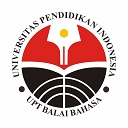The Formation of Abbreviated Loanwords in Japanese: A study of Ryakugo and Toujigo in Asahi Shimbun digital website of automotive-technology column
Abstract
In Japan, loanwords widely used in newspapers that make it difficult for readers to understand the information. As there is a need for a practical language, it has been proven by the more dominant use of abbreviations. In newspapers, abbreviations in loanwords are most commonly found in the field of automotive technology, but the use of abbreviations in newspaper must be taken into consideration, as it may be difficult to deliver the information. This study was arranged with the aim to find out, describe and analyse the formation of loanwords in ryakugoand toujigoform in the Asahi Shimbun Digitalwebsite. It is intended for Japanese learners to have a basic knowledge of the formation structure of the Japanese loanwords and to know the abbreviations and meanings of the automotive and technology fields term. The method used in this study is a descriptive qualitative analysis. The results of this study were obtained 79 data of ryakugoand toujigo, which in the formation of ryakugo were jouryaku, geryaku, and jougeryaku. While the formation of toujigo were keeping the first letter written with alphabet, keeping the first letter written with alpha-numeric, keeping the front–middle- in the first word and keeping two letters in the first word.
Keywords
Full Text:
PDF FULLTEXTReferences
Bilal, M. (2017). Analisis Kontrastif Abreviasi Dalam Bahasa Jepang Dan Bahasa Indonesia (Skripsi). Semarang: Universitas Diponegoro.
Fawsitt, J. (2016). The Phonological Features of Gairaigo.
Kamal, A.A. (2017). Analisis Kesalahan Penggunaan Huruf Katakana Dalam Penulisan Gairaigo Pada Siswa Kelas XI Di SMAN 1 Kabupaten Tangerang (Skripsi). Bandung: Universitas Komputer Indonesia. Tidak Dipublikasikan.
Kay, G. (1995). English Loanwords in Japanese. World Englishes, 1(1), 67-76.
Kindaichi, H. (1988). Nihongo Daijiten. Japan: Kodansha.
Miles, B. & Michael, H. (1992). Analisis Data Kualitatif. Jakarta: Uip.
Nadia. A. (2018). Pembentukan Strukutur dan Makna Kata Wasei-eigo dalam Bentuk Majemuk.(Skripsi). Bandung: Universitas Pendidikan Indonesia. Tidak Dipublikasikan.
Olah, B. (2007). English Loanwords in Japanese: Effects, Attitudes and Usage as a Means of Improving Spoken English Ability. Jurnal: Jurnal Penelitian Humaniora, 9(1), 177-188
Oshima, K. (2002). Semantic and Structural Shift Patterns of Gairaigo in Japan. Jurnal: Studi Komunikasi Antar Budaya International Christian University, 9(4).
Oshima, K. (2003). An overview of gairaigo studies: Implications for English Education. Educational Studies, 45, 151-158.
Oshima, K. (2004). The movement of gairaigo usage: The case of the Asahi newspaper from 1952 to 1997. Bunkyo Gakuin Daigaku Gaikokugo Gakubu Bunkyo Gakuin Daigaku Tankidaigaku Kiyoo, 3, 91-102.
Rasiban, L. M. (2014). Pemahaman Mahasiswa terhadap Penggunaan Katakana dalam Kata Serapan Bahasa Inggris (Eigo no Shakuyoogo) pada Bahasa Jepang. Jurnal Bahasa Asing.
Soelistyowati, D. (2010). Pembentukan Kata Pinjaman (Gairaigo) Dalam Bahasa Jepang. 6(2).
Sube, M. (2013). Katakana Eigo to Wasei Eigo: Saikin no Keikou wo chuushinshite (English Katakana and English Wasei: The latest tendency). カタカナ英語と和製英語 - 最近の傾向を中心して -. 環境と経営: 静岡産業大学論集, 19(2), 127-137.
Situs Internet:
https://automotive.ten-navi.com/dictionary/
https://www.asahi.com/
DOI: https://doi.org/10.17509/japanedu.v4i1.17079
Refbacks
- There are currently no refbacks.
Copyright (c) 2019 JAPANEDU: Jurnal Pendidikan dan Pengajaran Bahasa Jepang

This work is licensed under a Creative Commons Attribution-ShareAlike 4.0 International License.
 Published by:
Published by: Department of Japanese Language Education, Faculty of Language and Literature Education
Universitas Pendidikan Indonesia
 Online ISSN: Online ISSN:2528-5548 |

JAPANEDU: Jurnal Pendidikan dan Pengajaran Bahasa Jepang (e-ISSN:2528-5548) lisenced under a Creative Commons Attribution-ShareAlike 4.0 Internasional (CC BY-SA 4.0)


